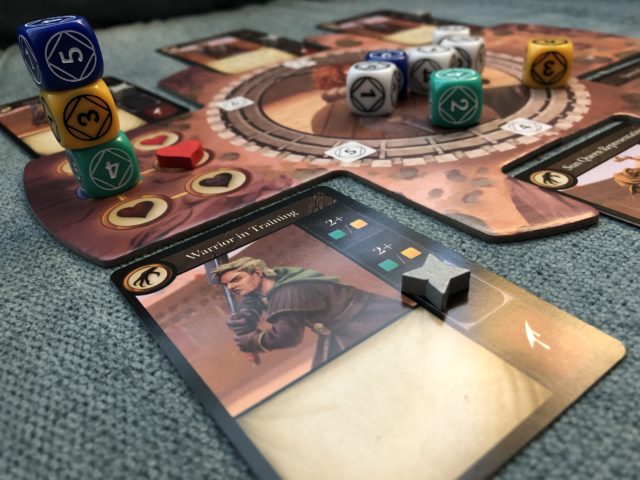It’s a classic trope in both cinema and videogames: the lone hero/ine, ringed by enemies. Feinting, fending, fighting for their life against all odds. Now you too, reader, can experience the thrills, dread, and triumph of the one-vs-many boss fight in Proving Grounds, first in what Renegade Games is calling its “Solo Hero Series”.
You play Maia Strongheart, a warrior princess who has been betrayed by a cabal of courtiers who chooses to maintain her innocence in a trial by combat against a multitude of opponents surrounding her on six sides. Every round you roll dice and assign them to your opponents, each occupying a numbered sector from one to six. It usually takes two or more dice (sometimes you must include one of the coloured dice in your pool) to wound an opponent; cause enough wounds and they die. Defeat eight attackers and you win. But if you get stuck placing just one die, though, they can damage you, and you can only take so much damage, too.
Although the game recalls some of the tower-defence mechanics of Victory Point Games’ “States of Siege” series, there are significant differences, not least of which is the fact that the dice-rolling phase is time-limited to one minute. You get as many re-rolls as you want of groups of dice as long as they all have the same face showing; singletons can not be re-rolled. I have scoured my memory and can’t recall any other solitaire tabletop game that has realtime elements, which makes Proving Grounds unique.
Winning even the basic game is challenging enough as it is. There is no obvious or optimal strategy. You’re playing six tugs-of-war simultaneously and you can’t fight everyone every turn. Attackers are randomly dealt from a deck and many have idiosyncrasies which make them easier or (usually) harder to defeat. Some, for example, must be fought every round or else they strike back.

But if the vanilla version proves too simple don’t worry: there are six (!) modules you can add, singly or together, to spice things up. One of them makes things strictly easier: you get an inspirational power which gives you a buff. Another gives you a dragonling ally who adds a special die to your dice pool which can be re-rolled only on its own. Five of its six outcomes are helpful, but the sixth forces you to reroll your coloured dice, which can really mess things up. The other four modules all make life more difficult (literally!) for Maia. The ultimate experience is using all six modules at once, but don’t try that til you’ve tried them separately, one or two at a time.
Proving Ground is truly a hybrid game: half dexterity, half tactical. You could definitely extend the time limit to ninety seconds or two minutes if you wanted to give yourself a break, nothing wrong with that. It would be a leisurely puzzly-thinky game, but too easy to win. As it stands the game manages to put you as the player right in the action, frenetically taking on one enemy, then another, dodging and weaving.
It should come as no surprise that the designer, Kane Klenko, has created a niche for himself with games that incorporate realtime play such as FUSE, Mad City, and most recently with Pandemic: Rapid Response. The game includes a separate booklet with a short story by Monica Valentinelli which establishes the backstory and gives you a reason to care about your character. Valentinelli made her name writing content for the Firefly RPG, so she knows a thing or two about world building and story crafting. However, the trial by combat she describes in her story doesn’t quite match up with the actual game’s narrative, which is slightly jarring but not a deal-killer for me. I mean, either the story came first and then Klenko had to make changes to improve gameplay, or else Valentinelli decided the game’s onslaught of samey enemies (see below) wasn’t dramatic enough.
My biggest knock against the game is that it may be a bit too hard in its vanilla mode, which is chancy for a game which markets itself as “a great place to start” for solo game n00bs. I’m astonished by some of the comments on BGG which compare it to Yahtzee and say it’s too easy. In my first game I thought I could assign dice to any enemy, not realizing I had to place them in the corresponding numbered sector, and I won really easily too. Were they making the same mistake?
My other quibble is the near-identical generic enemies you fight. They fall into several classes, each with different amounts of hit points, strengths, and weaknesses, and although there is some variation within each class, the sameness is a bit bland. The fact that they are given generic names (“Queen’s Bodyguard”, “Warrior in Training”) doesn’t help.
I don’t know how much later games in the Solo Hero Series will follow Proving Grounds’ template (including the accompanying fiction), but if you’re looking for a solo game that isn’t really like anything else out there, you should give it a try–but be prepared to die a few times before pulling off your first victory.
Thanks to Renegade Games for supplying a review copy of Proving Grounds.
Comments
No comments yet! Be the first!